THE SHELTERING SKY (1990)
An American couple travel abroad to rekindle their relationship. But as the trip drags on, their attempt at recovering what they once had seems futile.
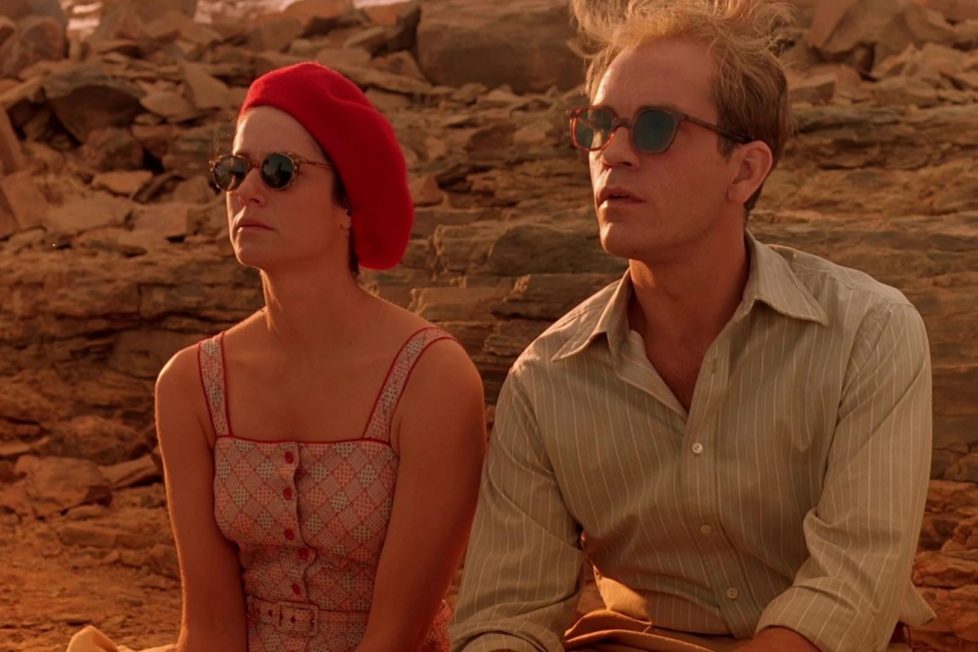
An American couple travel abroad to rekindle their relationship. But as the trip drags on, their attempt at recovering what they once had seems futile.


Living in self-imposed exile in Tangier, expatriate author Paul Bowles remained aloof from the hipsters and beatniks of the US. However, his 1949 novel The Sheltering Sky reads like a darker and mysterious version of Hemingway. His style has an undertow of hallucinogenic existentialism that evokes similarities to the early works of the Beats. Considered by many as one of the greatest pieces of 20th-century literature, it gained attention from directors such as William S. Burroughs (Naked Lunch) and Michelangelo Antonioni (L’Avventura). And more than 40 years after it was published, it was adapted for the screen by Academy Award-winning director Bernardo Bertolucci.
Bertolucci’s a director who’s always enjoyed shocking his audience. The graphic sexual depictions of Last Tango in Paris (1972) caused a lot of controversy, while his lesser-known La Luna (1979) depicted a highly sexualised mother-son relationship that made many uncomfortable. But in the early 1980s, Bertolucci was in a state of great artistic crisis, and in order to overcome it he travelled to the most unusual place: China. It was here he gained inspiration and made his visual masterpiece, The Last Emperor (1987). After winning nine Oscar’s (including ‘Best Picture’, ‘Best Director’, and ‘Best Screenplay’), he followed it up with The Sheltering Sky. In this second instalment of his ‘Eastern Trilogy’, the filmmaker combined the exploration of sexuality with his highly kinetic visual style.
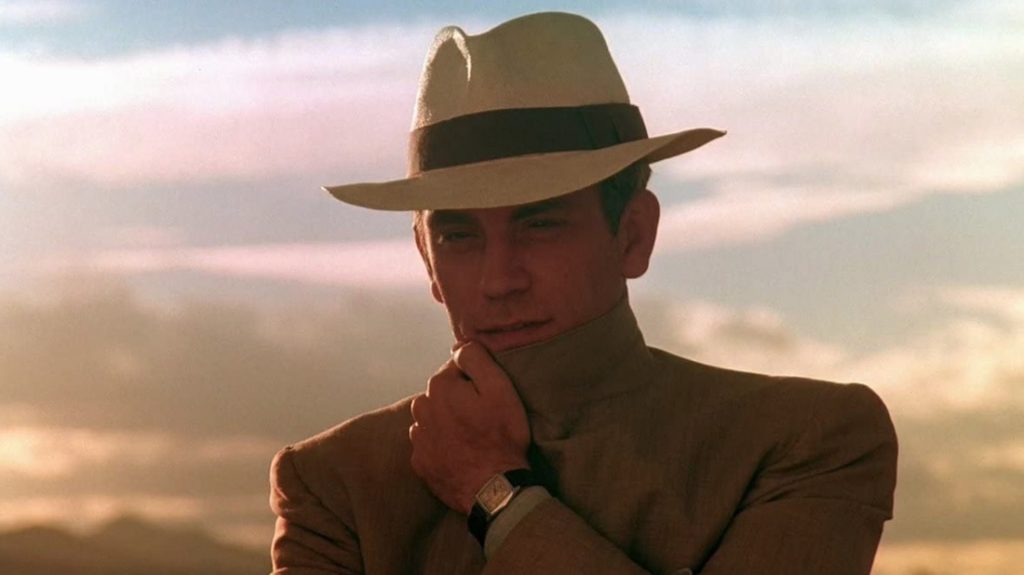
In the aftermath of World War II, three young Americans travel to North Africa in search of new experiences. Port (John Malkovich) is a composer who finds the Sahara speaks to his yearning for something unknowable. Whereas his wife, Kit (Debra Winger), is a writer hoping their journey will recapture the meaning of marriage. Accompanying the couple is their friend George Tunner (Campbell Scott), who’s secretly in love with Kit. As the three travel across Algeria, they find themselves pitted against cultures and environments they’re not used to… and tensions rise as their experience leads to heartbreak after a love-triangle exposes their desires and disappointments.
John Malkovich is something of an anomaly. Whenever he portrays expressive characters, such as Larry in Of Mice and Men (1992) and Cyrus in Con Air (1997), the actor shines. However, in more subtle and psychological roles, he’s often less convincing. Unfortunately, Malkovich is woefully miscast as the cultivated Port Moresby. Bowles’ Port is described as a wealthy, sincere liberal struggling to relate to others because of his existentialist worldview. A role one might imagine Robert Redford (The Great Gatsby) playing. Malkovich’s interpretation is an unsympathetic, humourless academic. The actor also brings his usual rigour of melancholy superiority, which adds a mocking tone throughout. There are fleeting moments when his philosophical ramblings shine, such as the distinction between travellers and tourists (“a tourist is someone who thinks of going home the moment they arrive. A traveler might not come back at all”), but he’s mainly a condescending pseudo-intellectual who comes across as pompous instead of profound.
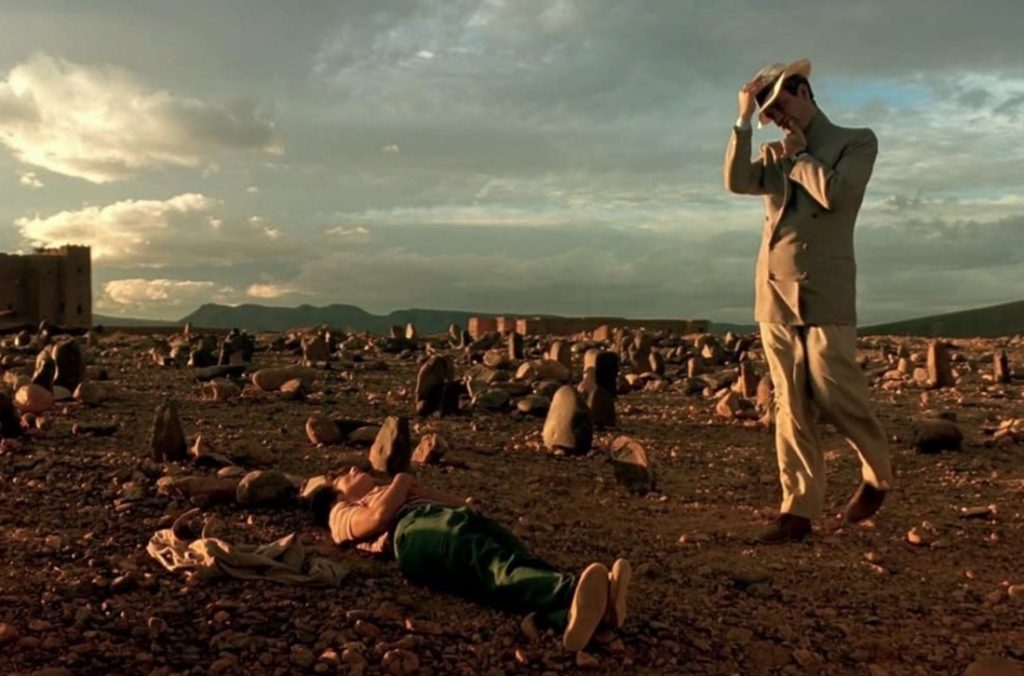
Debra Winger (Terms of Endearment) is captivating in her perky characterisation of Kit and her narrative is the focal point of the film. Her strong-willed attitude and excitement at women getting the vote in Italy bear no resemblance to the novel’s description of Kit, however. However, the actress throws herself into the role and succeeds at playing the fragile, neurotic character that Bowles describes on the page. Like a contemporary version of Rudolph Valentino’s The Sheik (1921), Kit’s spiritual and sensual journey begins when she joins a Bedouin caravan travelling across the Sahara. After meeting the seductive Belquassim (Eric Vu-an), she undergoes her sexual awakening. It’s in her passivity at the end, she finally finds herself liberated and free.
While Port and Kit’s journey is rather powerful, there are moments of light relief from the supporting cast. As their young travel companion, Campbell Scott (Big Night) is well-intentioned and naive as Tunner. Looking like he wandered in from a Whit Stillman’s Metropolitan (1990), he spends most of the time complaining about the food and the bugs. Meanwhile, Jill Bennet (The Nanny) is on fine form as the Fanny Craddock of travel writers, Mrs. Lyle. Regularly spewing racist contemptuous remarks about Africans and French Jews, she makes a living from those she disparages. Traveling alongside her is Timothy Spall (Early Man) as her impressively unsavoury son, Eric. The monstrous adult-baby is constantly scrounging money from Port, eventually stealing his passport. The Lyles are disgusting as they seem and represent one of the most notorious examples of a mother-son relationship outside of Psycho (1960).
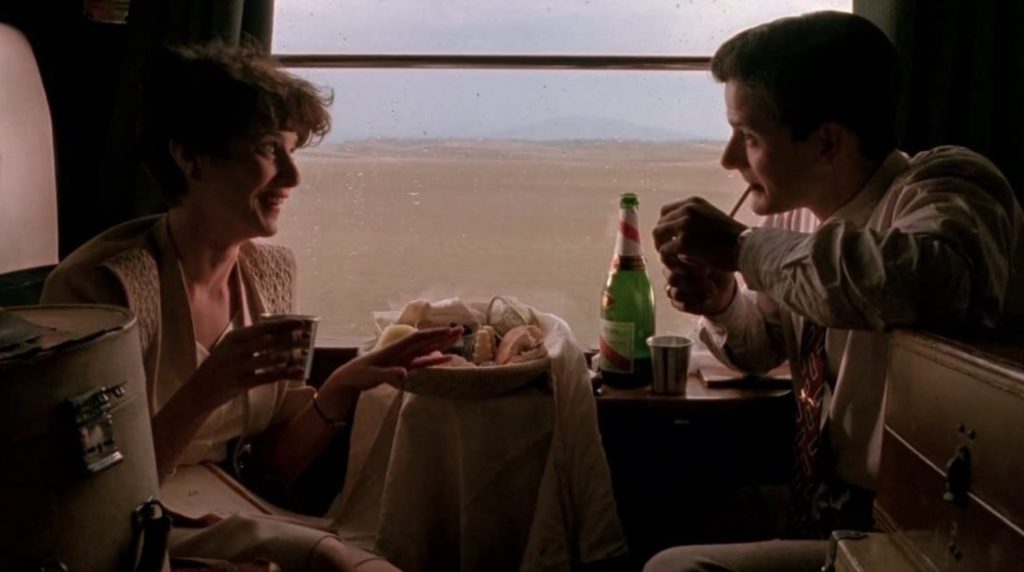
Admittedly, Malkovich and Winger give dignified performances whenever they’re on-screen together. Having lost the power to communicate with each other, the pair imbue their characters with emotional anguish hidden by a veneer of normalcy. Both Port and Kit know their relationship’s in turmoil but are too afraid to admit it. This marital torpor is acknowledged through their choice of sleeping in separate bedrooms and passive-aggressive remarks. Several scenes between Malkovich and Winger are poignantly captured as they attempt to understand each other and rekindle their passion. During one sequence, they discover an isolated spot overlooking a desert valley. Whilst making love, they both break down in tears before admitting “maybe we’re both afraid to love too much”. They are both searching for something, though neither could tell you what it is.
The essential problem with Malkovich and Winger’s performances lie in the failure to sympathise with the Moresby’s attempt to restore their crumbling marriage. Port and Kit are caricatures that would fit comfortably in an F. Scott Fitzgerald novel. They’re both young, wealthy, flamboyant, condescending, and have no care for moral decency. Throughout The Sheltering Sky, we see the two protagonists take reckless chances on purpose. Port indulges in visceral pleasures such as visiting exotic dancers and following a strange native to a local brothel. Where he spends the night with a prostitute while his wife waits in their hotel room. Whereas Kit chooses to drink champagne with Tunner during a seven-hour train ride, resulting in them sleeping together. Unfortunately, the two primary characters remain detached and unlikable making it difficult to become involved or empathise with their plights.
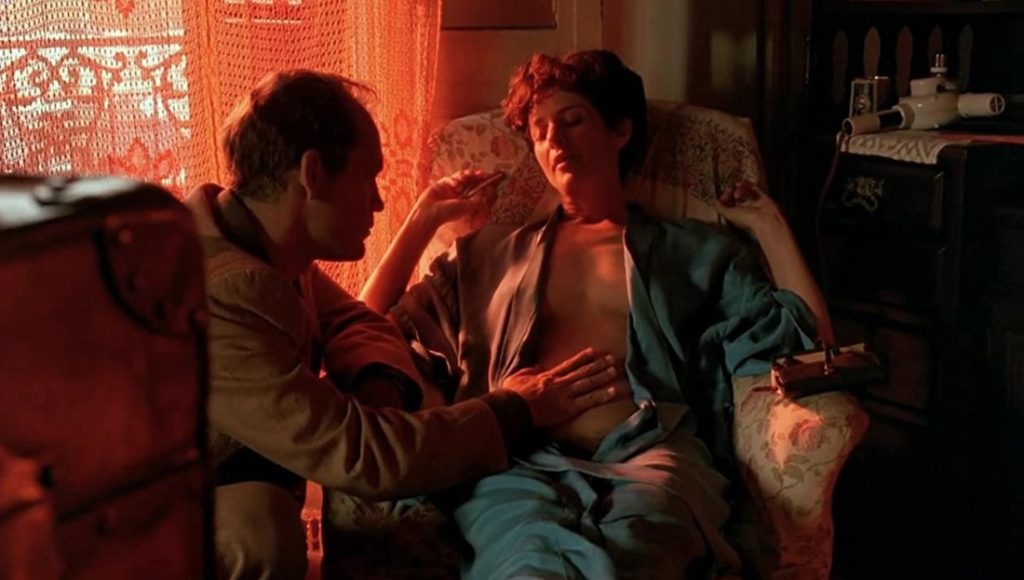
The Sheltering Sky resounds and shines with Bertolucci’s touch. Anyone familiar with the director’s work should expect his features to be long on mood and milieu. Although it’s a far cry from the 320-minute runtime of 1900 (1976), at 137-minutes The Sheltering Sky is slow and cerebral. However, using the author as a consultant and on-screen narrator, the director is able to produce the correct visual experience. Fly’s act as unpaid extras as they surreptitiously crawl across character’s faces during a humid bus journey through the desert. One can almost smell the fragrance of herbs and spices in the Moroccan markets. The director’s use of camera angles and mise-en-scène gracefully conveys its themes of exploration, sex, and solitude. An early scene shows Kit opening her suitcase with a close-up of Djuna Barnes’ novel Nightwood sitting on top. Foreboding that elastic sexual identities will have a place in the story. Whereas his compositions focus on empty spaces as his characters are dwarfed by their surroundings, suggesting the characters’ isolation in the vast desert.
If Bertolucci’s classical mise-en-scène feels inappropriate in the first half, it’s because he was building towards his vast panoramic shots for the second. As he did with The Last Emperor, the director successfully transports us to a visually alluring and exotic world. Filmed in Algeria, Niger, and Morocco, the beautiful cinematography from the extraordinary Vittorio Storaro (Apocalypse Now) is a visual feast. Initially opening with a black-and-white paean to New York City, he turns his lens to tawny yellows to establish the Saharan landscapes. Evoking similarities to Freddie Francis’ work in Lawrence of Arabia (1962), the breathtaking African desert is a character unto itself. Moreover, Ryuichi Sakamoto’s (Merry Christmas, Mr. Lawrence) score is equally memorable. Simultaneously combining Arab calls and North African music, emphasising a significant amount of tragedy lamenting Kit and Port’s doomed relationship.
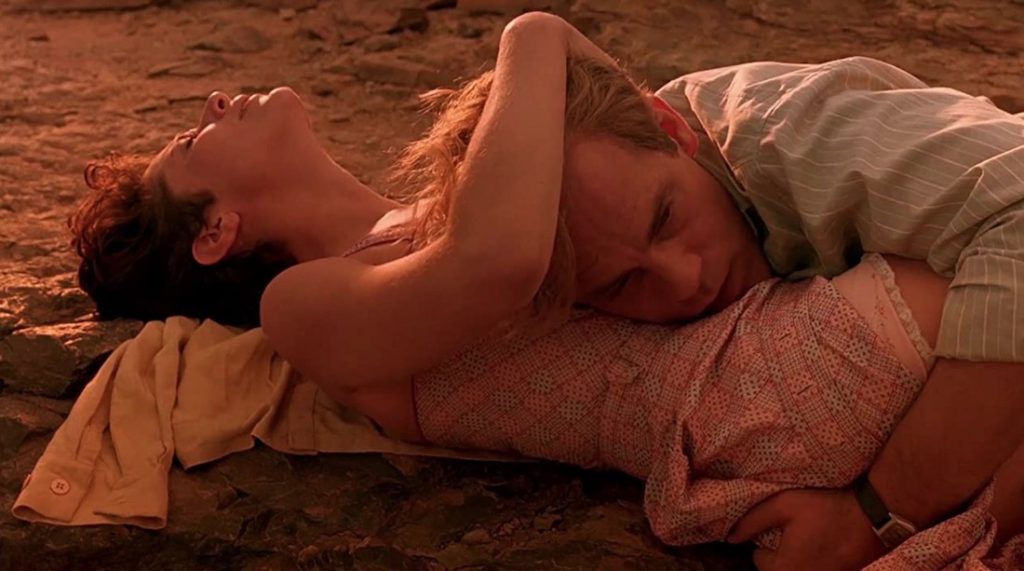
Considered impossible to film by many directors, Bertolucci makes a heroic attempt to adapt Bowles’ novel. Similar to E.M Forster’s A Passage to India, The Sheltering Sky is a story about alienation in both social and spiritual sense. The novel plays with the human psyche when they’re surrounded by unfamiliar environments and without the security of familiar places and people. It’s a tale about two lost souls who fall into the abyss of their own minds and Bertolucci fails to convey this. Admittedly, the director attempts to express hidden meanings to reveal the character’s distress with some creative sequences. We see Kit travelling through a labyrinth of dark passageways in El Ga, creating a sense of helplessness. Along with Port’s vivid hallucinations as he’s wracked with pain from Typhoid. Sure, it’s dazzling and horrifying. However, the director doesn’t translate the surreal writhing of the mind from the book to the screen.
Over the years I’ve found many of Bertolucci’s features uneven. He’s simultaneously capable of creating meaningful films such as The Conformist (1970), along with the dreadfully tedious Last Tango in Paris. Since the release of The Sheltering Sky, Bowles has subsequently disowned the adaptation, saying “it should never have been filmed. The ending is idiotic and the rest is pretty bad”. Unfortunately, I have to agree. The weakness consists of the excessive length and incredibly slow pace. As Port says in one scene “God! What a bore”. Admittedly, the luscious landscapes make some beautiful visuals. However, due to the drawn-out narrative and uneven performances, The Sheltering Sky unravels as Last Tango in Tangier.
UK • ITALY | 1990 | 138 MINUTES | 1.85:1 | COLOUR | ENGLISH • FRENCH • ARABIC

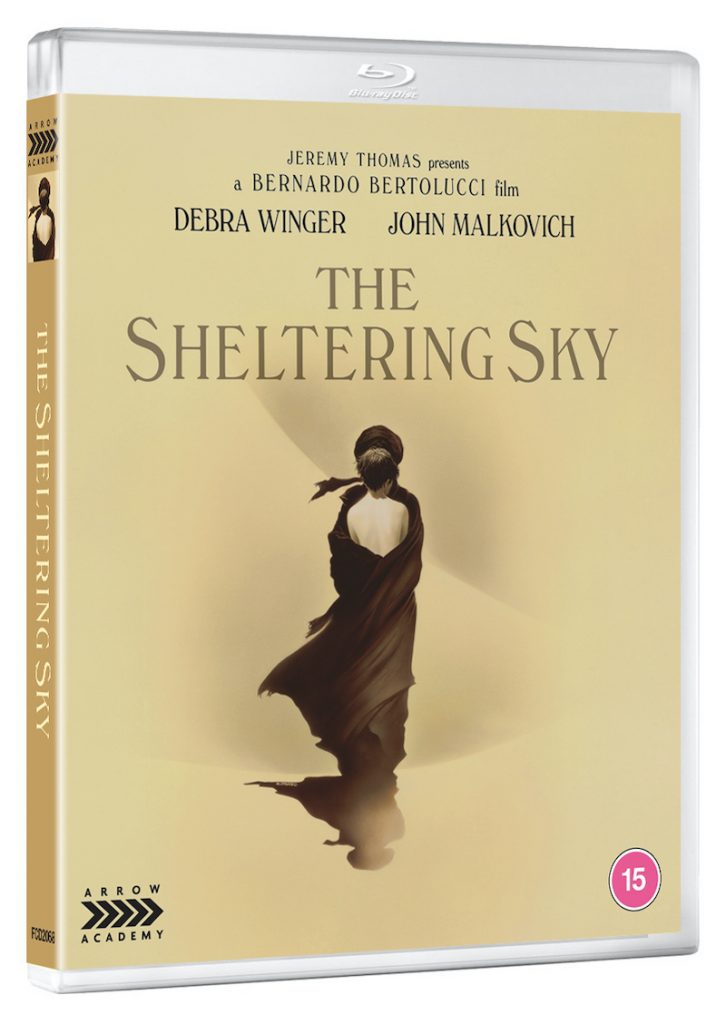
Presented in 1080p and in the original aspect ratio of 1:85:1 The Sheltering Sky is an undeniably stunning visual experience. Landscape shots sparkle with clarity and depth, drawing the eyes towards the infinite desert vistas. Colours are resplendent, especially the golden brown sand and gorgeous blue sky. Details and textures are strong, everything from camel fur to clothing fibers is sharp and prominent. Flesh tones are terrific and remain natural throughout, with every pore and bead of sweat visible. As the story progresses, a speck of constant dirt resides upon the cast along with a natural sun-tan from the African sun. Blacks are deep and inky, whereas the midnight blue sky as Kit travels through the desert with a caravan provides a soothing mystique. Eagle eye viewers will notice specs of dust and grain occasionally. However, they don’t affect the viewing experience.
The Sheltering Sky features an original uncompressed 5.1 DTS-HD audio track, creating a bold and robust experience. Like most Bertolucci features, the music is certainly a highlight and a necessary ingredient for shaping The Sheltering Sky’s experience. Opening with Ryuichi Sakamoto’s overture of “The Sheltering Sky Theme”, the composer’s stunning score has never sounded better. It’s immersive and compliments the visuals surrounding the soundstage. There’s a good power of rhythm of the native drums as they naturally fill the rear channels. During Port’s hallucination sequence, it genuinely feels like one is sat amongst musicians beating their djembe. Ambient noises are handled incredibly well, including environmental effects such as heavy gusts of wind and crowded chatter. The bustling city of El Ga sounds incredibly vibrant and immersive surrounding the rear channels. Subtleties including the sampling of camel-feet and rattling metals are all clear and believable, making use of the central channels.

director: Bernardo Bertolucci.
writers: Mark Peploe & Bernardo Betolucci (based on the novel by Paul Bowles).
starring: Debra Winger, John Malkovich, Campbell Scott, Jill Bennett, Timothy Spall & Eric Vu-An.
